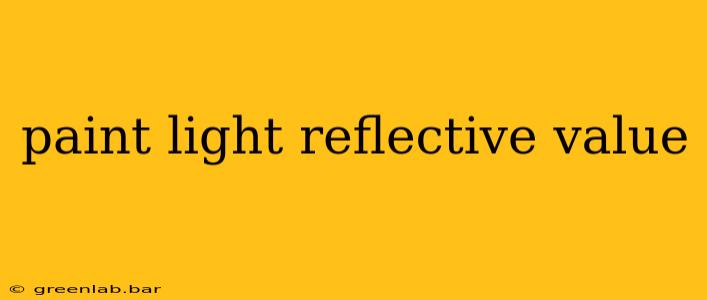Light Reflective Value (LRV) is a crucial factor to consider when choosing paint for any space, impacting not only the aesthetics but also the functionality and overall atmosphere of a room. Understanding LRV allows for informed decisions that optimize light, mood, and the perceived size of a room. This comprehensive guide delves into the significance of LRV in paint selection, offering practical advice for homeowners and interior design professionals alike.
What is Light Reflective Value (LRV)?
LRV is a percentage representing the amount of light a paint color reflects. A higher LRV indicates a greater reflection of light, resulting in a brighter space. Conversely, a lower LRV means more light absorption, creating a darker and potentially more intimate environment. LRV is typically expressed as a number between 0 and 100, where 0 represents total absorption (pure black) and 100 represents total reflection (pure white).
How LRV Impacts Your Space
The impact of LRV extends beyond simply the brightness of a room. Consider these key aspects:
-
Brightness and Spaciousness: High-LRV paints (lighter colors) make rooms feel larger and brighter, ideal for smaller spaces or rooms with limited natural light. Low-LRV paints (darker colors) create a cozier, more intimate feel, potentially making larger rooms feel more comfortable and less cavernous.
-
Mood and Atmosphere: The psychological impact of color is significant. Light colors generally evoke feelings of calmness and spaciousness, while darker colors can create a sense of drama, sophistication, or even warmth depending on the specific shade and undertones. LRV plays a pivotal role in setting the desired mood.
-
Energy Efficiency: High-LRV paints reflect more sunlight, reducing the need for artificial lighting and potentially lowering energy consumption. This is a significant benefit in both residential and commercial settings.
-
Color Perception: LRV influences how other colors in a room are perceived. A darker background can make brighter colors appear more vibrant, while a lighter background can soften or mute them.
Choosing the Right LRV for Your Needs
Selecting the appropriate LRV involves considering several factors:
-
Room Size and Light: Smaller rooms or those with limited natural light benefit from high-LRV paints. Larger rooms can accommodate lower-LRV paints without feeling too dark. Consider the direction your room faces; north-facing rooms often require higher LRV paints to compensate for less sunlight.
-
Desired Mood: Define the atmosphere you want to create. A relaxing bedroom might benefit from a high-LRV, calming color, while a dramatic dining room might be enhanced with a lower-LRV, sophisticated shade.
-
Existing Furnishings and Decor: The existing color palette of your furniture, flooring, and artwork should be considered. Choose a paint LRV that complements and enhances these elements.
-
Undertones: Even within the same LRV range, colors with different undertones (e.g., warm or cool) will impact the overall feel of a room. Consider the subtle nuances of color to achieve the desired effect.
Where to Find LRV Information
Most paint manufacturers provide LRV information for their colors, either on their websites or on the paint can itself. This data is crucial for making informed decisions. Many paint stores offer tools and resources to help you visualize the effect of different LRVs in your space.
Conclusion
Light Reflective Value is more than just a technical specification; it's a crucial design element influencing the functionality, aesthetics, and overall atmosphere of any space. By understanding and utilizing LRV effectively, you can transform your living environment into a space that reflects your personal style and optimizes both comfort and energy efficiency. Remember to consult with design professionals or use available tools to visualize the impact of different LRVs before committing to a final choice.

